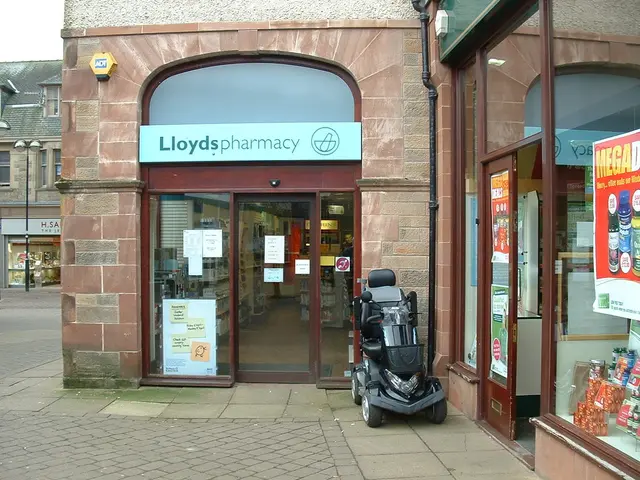Differentiating Age Spots from Skin Cancer: Recognizing the Signs and Symptoms
Harmless age spots, often referred to as solar lentigines or liver spots, are common skin markings that tend to manifest with age. These darker patches, typically on sun-exposed areas such as the face, hands, and shoulders, can resemble certain types of skin cancer. However, they are benign and do not necessitate treatment.
Understanding the key differences between age spots and skin cancer can assist individuals in identifying when professional medical advice might be required. Differences can encompass texture, color, and placement.
Distinguishing Age Spots from Skin Cancer
While age spots and skin cancer may look alike, there are notable differences:
Age Spots:- Characteristics: Flat, round or oval, brown or gray patches.- Localization: Generally appear on sun-exposed areas.- Surface: Smooth.- Shading: Color can be uniform or have varying shades depending on the type. Darker age spots are more defined, while sun spots might be lighter.
Skin Cancer:1. Basal Cell Carcinoma: - Manifestations: Small, pink or red bumps with elevated edges and a depression in the center; possible areas of black, blue, or brown. - Symptoms: Itching, open sores that bleed, ooze, and crust over.
- Squamous Cell Carcinoma:
- Presentation: Red, scaly patches or raised lumps with a depression in the center, growths resembling warts.
- Symptoms: Open sores that don't heal, bleeding, and crusting over.
- Melanoma:
- Aspect: Asymmetrical moles with jagged borders, multiple colors, and can be larger in diameter.
- Indications: Follow the ABCDE rule to identify: Asymmetrical, Border irregularity, Color variation, Diameter greater than 6 mm, and Evolving over time.
Assigning significance to any new, changing, or unusual skin growths is crucial to rule out skin cancer. Age spots may seem innocuous, yet they can be mistaken for other conditions requiring medical attention.
Identifying Skin Cancer Symptoms
Comparing age spot symptoms with those of skin cancer can help distinguish one from the other:
Age Spot Symptoms:- Traits: Flat, smooth, round or oval, definite borders, various sizes. Appear on sun-exposed areas.- Temporal behavior: Can fade in winter and increase in summer due to increased sun exposure.
Skin Cancer Symptoms:- Features: Asymmetrical shape, irregular edges, changing size, multiple colors on the same spot, pink, blue, purple, black, or brown coloring, raised, red patches, and pale or yellow firm patches. Crusty, scaly patches and elevated edges that sink in the middle may also occur.- Actinic Keratosis: Raised, rough, scaly patches, pink, gray, or skin-colored patches that can resemble age spots, appearing as flat scaly patches or scaly, rough bumps similar to acne, especially on sun-exposed areas like the face and hands.
Seek medical advice if a skin mark changes, doesn't match other marks, itches, crusts over, scabs, or doesn't heal within 4 weeks. Early identification of skin cancer improves treatment outcomes.
Diagnosis and Treatment
Through physical examination, doctors assess appearance, texture, and placement to determine whether a spot might be something other than an age spot. Skin biopsies may be conducted to test for skin cancer or actinic keratosis, depending on the results of the examination.
The results of a skin biopsy indicate whether a person has skin cancer or another skin condition. Age spots do not require treatment, but some individuals may opt for treatment to reduce their appearance. Potential treatments for age spots include creams, lotions, and procedures such as laser treatments, cryosurgery, microdermabrasion, and chemical peels.
Treatment for skin cancerdepends on various factors, including cancer type and individual circumstances, and can include surgical removal, topical therapies, radiation therapy, chemotherapy, immunotherapy, or systemic medication.
Understanding the differences between age spots and skin cancer, and recognizing the signs of skin cancer, can empower individuals to make informed decisions about their skin health and seek necessary medical attention.
[1] Skin Cancer Foundation. (n.d.). ABCDE Rule. Retrieved September 12, 2022, from https://www.skinancer.org/spot-check-yourself/abcde-rule/
[2] American Academy of Dermatology. (n.d.). Aging and Your Skin. Retrieved September 12, 2022, from https://www.aad.org/public/diseases/a-z/aging-skin
[3] Mayo Clinic. (2022, May 24). Age spots. Retrieved September 12, 2022, from https://www.mayoclinic.org/diseases-conditions/age-spots/symptoms-causes/syc-20378896
[4] American Cancer Society. (n.d.). Skin Cancer: Signs and Symptoms. Retrieved September 12, 2022, from https://www.cancer.org/cancer/skin-cancer/basal-and-squamous-cell-skin-cancer/signs-and-symptoms.html
[5] American Academy of Dermatology. (n.d.). Age Spots (Lentigos). Retrieved September 12, 2022, from https://www.aad.org/public/diseases/a-z/age-spots-treatment
[6] Cleveland Clinic. (2020, December 9). Age Spots (Liver Spots) vs. Skin Cancer. Retrieved September 12, 2022, from https://health.clevelandclinic.org/age-spots-vs-skin-cancer/
[7] National Cancer Institute. (2014, March 28). Skin Cancer Prevention (PDQ®). Retrieved September 12, 2022, from https://www.cancer.gov/types/skin/hp/skin-prevention-pdq#section/_114
- Seniors may be concerned about age spots on their skin, as these can resemble certain types of skin cancer, but they are generally benign and do not necessitate treatment, characterized by being flat, round or oval, brown or gray patches that appear on sun-exposed areas and have smooth surfaces.
- Oncology professionals often encounter cases of skin cancer, such as basal cell carcinoma, squamous cell carcinoma, and melanoma, which have distinct characteristics like raised, red patches, pink, blue, purple, black, or brown coloring, and irregular edges that require early identification and medical intervention.
- Dermatology plays a crucial role in diagnosing skin conditions, and medical-conditions such as actinic keratosis, a precancerous skin condition caused by exposure to excessive sunlight, can sometimes appear similar to age spots.
- Science has made significant strides in the understanding of health-and-wellness, leading to innovations in skin-care treatments for various conditions, including age spots, skin cancer, and other types of skin cancer like melanoma.
- Early identification of skin cancer can improve treatment outcomes, and maintaining awareness of potential skin cancer symptoms, such as changing, unusual, or persistent skin growths, is essential for individuals to seek prompt medical advice.








